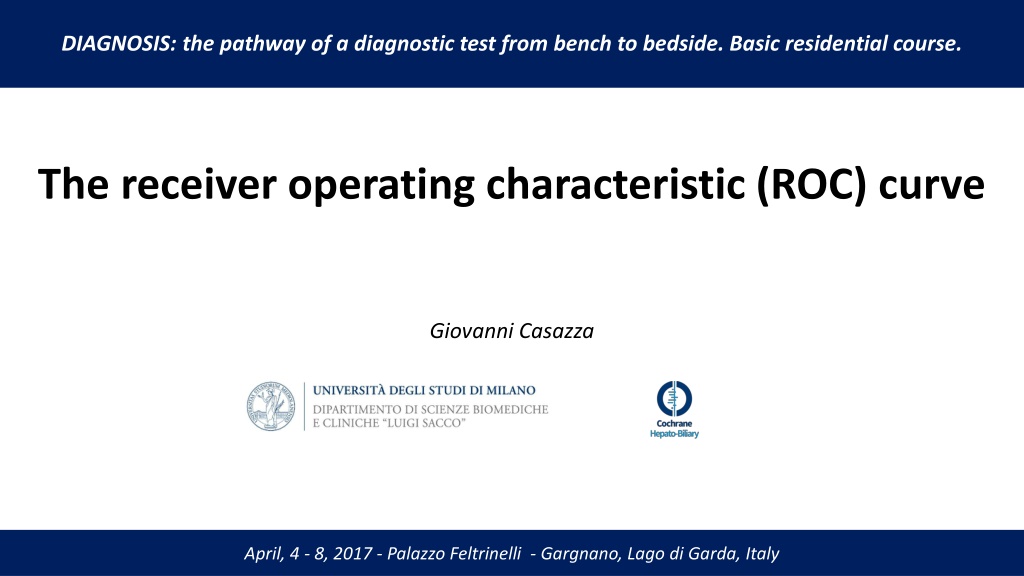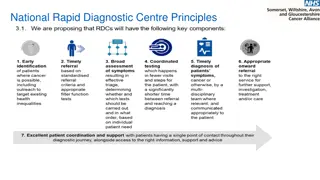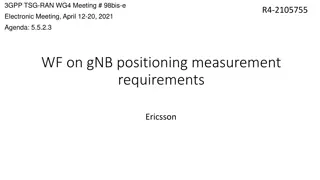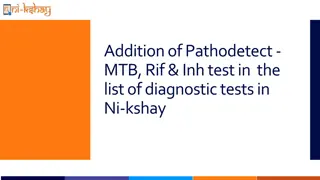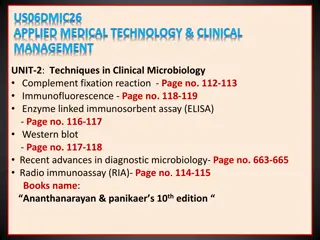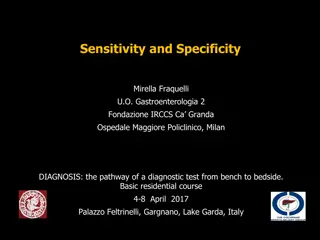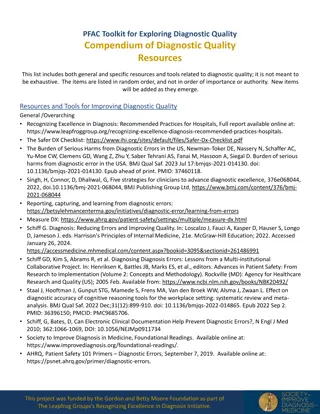Understanding Diagnostic Test Accuracy: A Practical Overview
Navigate through the pathway of diagnostic test development, implementation, and evaluation from bench to bedside. Explore the Receiver Operating Characteristic (ROC) curve, the impact of cut-off variations on sensitivity and specificity, and the practical application of continuous measurement in diagnostic accuracy studies. Gain insights into interpreting ROC curves, analyzing sensitivity and specificity results, and understanding the interplay between true positive, true negative, false positive, and false negative results.
Download Presentation

Please find below an Image/Link to download the presentation.
The content on the website is provided AS IS for your information and personal use only. It may not be sold, licensed, or shared on other websites without obtaining consent from the author. Download presentation by click this link. If you encounter any issues during the download, it is possible that the publisher has removed the file from their server.
E N D
Presentation Transcript
Outline DIAGNOSIS: the pathway of a diagnostic test from bench to bedside. Basic residential course. The receiver operating characteristic (ROC) curve Giovanni Casazza April, 4 - 8, 2017 - Palazzo Feltrinelli - Gargnano, Lago di Garda, Italy
Outline Effect of cut-off variation on sensitivity and specificity Graphical representation of the relationship between sensitivity and specificity (ROC curve) A summary measure of the overall accuracy (AUC) Reading a ROC curve
A diagnostic accuracy study: spleen sriffness Spleen stiffness: continuous measurement
Continuous index test results Test + Test n=36 n=24
Continuous index test results Test + Sensitivity: 23/24=95.8% 23/24 test + 1/24 test Test n=36 n=24
Continuous index test results Test + Specificity: 28/36=77.8% 8/36 test + 28/36 test Test n=36 n=24
Continuous index test results Sensitivity: 23/24=95.8% Test + Specificity: 28/36=77.8% 8/36 test + 28/36 test Any EV + FP TP + 23 8 31 1 28 29 TN FN Tot 24 36 23/24 test + 1/24 test Test n=36 n=24
Continuous index test results Sensitivity: 6/24=25% Specificity: 36/36=100% 0/36 test + 36/36 test 6/24 test + 18/24 test 3.95 n=36 n=24
Continuous index test results Sensitivity: 9/24=37.5% Specificity: 35/36=97.2% 1/36 test + 35/36 test 9/24 test + 15/24 test 3.75 n=36 n=24
Continuous index test results Sensitivity: 11/24=45.8% Specificity: 35/36=97.2% 1/36 test + 35/36 test 11/24 test + 13/24 test 3.68 n=36 n=24
Continuous index test results Sensitivity: 15/24=62.5% Specificity: 34/36=94.4% 2/36 test + 34/36 test 15/24 test + 9/24 test 3.59 n=36 n=24
Continuous index test results Sensitivity: 23/24=95.8% Specificity: 22/36=61.1% 14/36 test + 22/36 test 23/24 test + 1/24 test 3.25 n=36 n=24
Continuous index test results Sensitivity: 24/24=100% Specificity: 10/36=27.8% 26/36 test + 10/36 test 24/24 test + 0/24 test 3.00 n=36 n=24
Continuous index test results Sensitivity: 24/24=100% Specificity: 18/36=50% 18/36 test + 18/36 test 24/24 test + 0/24 test 3.15 n=36 n=24
The threshold Any EV Any EV + + + 6 0 6 + 9 1 10 SS >3.95 SS >3.75 18 36 54 15 35 50 Tot 24 36 Tot 24 36 Any EV Any EV + + + 11 1 12 + 15 2 17 SS >3.68 SS >3.59 13 35 48 9 34 43 Tot 24 36 Tot 24 36
The threshold Any EV Any EV + + + 23 8 31 + 23 14 37 SS >3.36 SS >3.25 1 28 29 1 22 23 Tot 24 36 Tot 24 36 Any EV Any EV + + 24 18 42 + 24 26 50 SS >3.15 SS >3.00 0 18 18 0 10 10 Tot 24 36 Tot 24 36
Summary of thresholds - Table Cut-off value Test + Test - Sensitivity Specificity 3.95 6 54 25 100 3.75 10 50 37.5 97.2 3.68 12 48 45.8 97.2 3.59 17 43 62.5 94.4 3.36 31 29 95.8 77.8 3.25 37 23 95.8 61.1 3.15 42 18 100 50 3.00 50 10 100 27.8
Trade-off between sensitivity and specificity Unfortunately, as specificity increases, sensitivity decreases. cut-off pt SS As the cut-off increases: only patients with higher SS values are classified as positive. 3.15 3.59 3.95 3.02 3.14 3.25 3.40 3.65 3.80 3.98 4.05 4.40 1 2 3 4 5 6 7 8 9 - - + + + + + + + - - - - + + + + + - - - - - - + + + Less (true and false) positive patients; more (true and false) negative patients. Less true positives Sensitivity decreases Sens=TP/(TP+FN) Less false positives Specificity increases Spec=TN/(TN+FP)
Trade-off between sensitivity and specificity Unfortunately, as sensitivity increases, specificity decreases. cut-off pt SS As the cut-off decreases: only patients with lower SS values are classified as negatives. 3.15 3.59 3.95 3.02 3.14 3.25 3.40 3.65 3.80 3.98 4.05 4.40 1 2 3 4 5 6 7 8 9 - - + + + + + + + - - - - + + + + + - - - - - - + + + Less (true and false) negative patients; more (true and false) positive patients. More true positives Sensitivity increases Sens=TP/(TP+FN) More false positives Specificity decreases Spec=TN/(TN+FP)
Summary of thresholds - Graphic 1 0.9 Cut-off value value Sensitivity Sensitivity Specificity Specificity 1-specificity Cut-off 0.8 3.95 3.95 0.250 0.250 1.000 1.000 0.000 0.7 3.75 3.75 0.375 0.375 0.972 0.972 0.028 0.6 3.68 3.68 0.458 0.458 0.972 0.972 0.028 Sensitivity 3.59 3.59 0.625 0.625 0.944 0.944 0.056 0.5 3.36 3.36 0.958 0.958 0.778 0.778 0.222 0.4 3.25 3.25 0.958 0.958 0.611 0.611 0.389 0.3 3.15 3.15 1.000 1.000 0.500 0.500 0.500 3.00 3.00 1.000 1.000 0.278 0.278 0.722 0.2 0.1 0 1.0 0 0.1 0.9 0.2 0.8 0.3 0.7 0.4 0.6 0.5 0.5 0.6 0.4 0.7 0.3 0.8 0.2 0.9 0.1 1 0 1-Specificity Specificity
Summary of thresholds - Graphic 1 0.9 If we do the same for all the possible cut-off values 0.8 0.7 0.6 Sensitivity 0.5 0.4 0.3 0.2 0.1 0 1.0 0.9 0.8 0.7 0.6 0.5 0.4 0.3 0.2 0.1 0.0 0 0.1 0.2 0.3 0.4 0.5 0.6 0.7 0.8 0.9 1-Specificity Specificity 1
The ROC curve 1 0.9 0.8 This curve is known as the Receiver Operating Characteristic (ROC) curve. 0.7 0.6 Sensitivity 0.5 0.4 0.3 0.2 0.1 0 1.0 0.9 0.8 0.7 0.6 0.5 0.4 0.3 0.2 0.1 0.0 0 0.1 0.2 0.3 0.4 0.5 0.6 0.7 0.8 0.9 1-Specificity Specificity 1
The ROC curve 1 cut-off: 3.36 Sens=0.958 Spec=0.778 0.9 0.8 0.7 cut-off: 3.59 Sens=0.625 Spec=0.944 0.6 Sensitivity 0.5 0.4 0.3 0.2 0.1 0 1.0 0.9 0.8 0.7 0.6 0.5 0.4 0.3 0.2 0.1 0.0 0 0.1 0.2 0.3 0.4 0.5 0.6 0.7 0.8 0.9 1-Specificity Specificity 1
The ROC curve 1 The area under the ROC curve (AUC) is a (summary) measure of diagnostic accuracy 0.9 0.8 0.7 0.6 AUC is a measure of the ability of the continuous index test to discriminate between diseased and non diseased AUC=0.937 0.5 0.4 0.3 0.2 0.1 0 1.0 0.9 0.8 0.7 0.6 0.5 0.4 0.3 0.2 0.1 0 0 0.1 0.2 0.3 0.4 0.5 0.6 0.7 0.8 0.9 1
The ROC curve Inidividual patients plot Box plot
The ROC curve HVPG vs LS for a Target Condition: which of the two has the higher AUC?
The ROC curve Platelet count/spleen diameter ratio: proposal and validation of a non-invasive parameter to predict the presence of oesophageal varices in patients with liver cirrhosis Gut 2003;52:1200 1205
The ROC curve The perfect test: sensitivity and specificity both 100%. 1.0 0.9 0.8 0.7 0.6 0.5 0.4 0.3 0.2 0.1 0
The ROC curve Is that test useful for ? A new index test with sensitivity 99% and specificity 1%. The worthless test like flipping a coin. What is the value of LRs? LR+=1 for each point of the curve LR -=1 for each point of the curve 0.99 1.0 0.9 0.8 0.7 0.6 0.5 0.4 0.3 0.2 0.1 0 0.01
The ROC curve Correlation of platelets count with endoscopic findings in a cohort of Egyptian patients with liver cirrhosis Medicine (2016) 95:23 Reading the results of a study
The ROC curve Reading a ROC curve Choosing the cut-off value
Take home points The ROC curve as a summary of the pairs (sensitivity, specificity) at each cut-off. Do not give too much importance to the value of AUC: read the whole curve. Assess if the test is (and how much is) useful to rule-in or to rule-out the target condition. AUC may be useful to compare the overall accuracy of two or more tests
